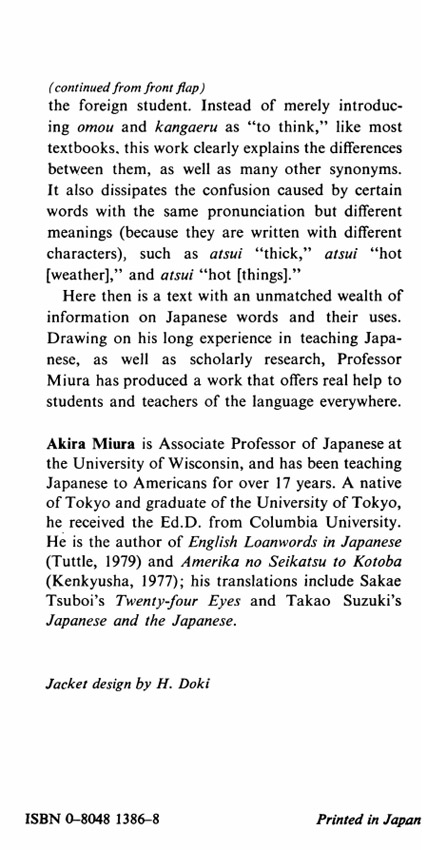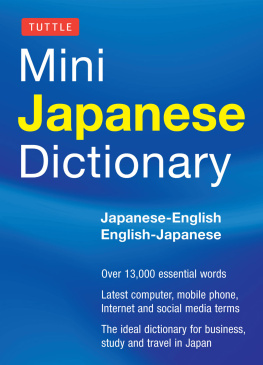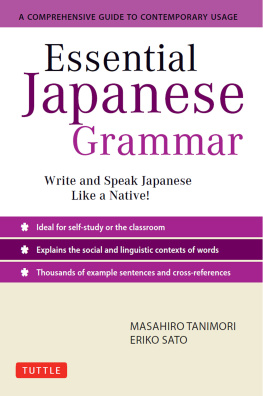
BIBLIOGRAPHY

Bunka-cho (Agency for Cultural Affairs). Gaikokujin no tame no Kihongo Yorei Jiten (A Dictionary of Basic Words for Foreigners). Tokyo: Bunka-cho, 1971. Hattori, Shiro. Eigo Kiso-goi no Kenkyu (A Study in the Basic Vocabulary of English). Tokyo: Sanseido, 1968.
Ikegami, Yoshihiko. Imi no Sekai (The World of Meaning). Tokyo: Nihon Hoso Shuppan Kyokai, 1978. Jorden, Eleanor Harz. Beginning Japanese. 2 vols.
New Haven and London: Yale University Press, 1963. Keene, Donald. Nihongo no Muzukashisa (The Difficulty of Japanese). In Watashi no Gaikokugo (My Foreign Language), edited by Tadao Umesao and Michio Nagai, pp. 154-63. Tokyo: Chuokoronsha, 1970.
Kindaichi, Haruhiko, ed. Meikai Nihongo Akusento Jiten (A Clearly Explained Dictionary of Japanese Accent), 6th ed. Tokyo; Sanseido, 1962. Kunihiro, Tetsuya. Kozoteki Imiron (Structural Semantics). Tokyo: Sanseido, 1967.
Kuno, Susumu. The Structure of the Japanese Language. Cambridge, Mass., and London: MIT Press, 1973. Kurokawa, Shozo. Nihongo to Eigo no Aida (Between Japanese and English). Tokyo: Natsumesha, 1978.
Maruya, Saiichi. Nihongo no tame ni (For the Japanese Language). Tokyo: Shinchosha, 1974. Matsui, Emi. Eisakubun ni okeru Nihonjinteki Ayamari (Japanese-like Errors in English). Tokyo: Taishukan, 1979.
Matsuo, Hirou, et al. Ruigigo no Kenkyu (A Study of Synonyms). Report no. 28 by Kokuritsu Kokugo Kenkyujo (The National Language Research Institute). Tokyo: Shuei Shuppan, 1965. Miura, Akira, English Loanwords: A Selection.
Tokyo and Rutland, Vt.: Charles E. Tuttle, 1979. Miyoshi, Hiroshi. Nichi-Ei Kotoba no Chigai (Differences Between Japanese and English Expressions). Tokyo: Koronsha, 1978. Mizutani, Osamu, and Mizutani, Nobuko.
Nihongo Notes, 1. Tokyo: The Japan Times, 1977. .Nihongo Notes, 2. Tokyo: The Japan Times, 1979. Morita, Yoshiyuki. Kiso Nihongo (Basic Japanese).
Tokyo: Kadokawa Shoten, 1977. Ogasawara, Rinju. Eigo-jisho to Nichi-Ei Goi no Hikaku (A Comparison of the Japanese and English Vocabularies Through English-Language Dictionaries). In Nichi-Eigo no Hikaku (A Comparison of Japanese and English), edited by Kenkyusha, pp. 115-39. Tokyo: Kenkyusha, 1978.
Ohno, Susumu, and Shibata, Takeshi, eds. Goi to Imi (Words and Meanings). Iwanami Koza: Nihongo (Iwanami Course: The Japanese Language), 9. Tokyo: Iwanami Shoten, 1977. Sandness, Karen. The Use of Kare and Kanojo.
Journal of the Association of Teachers of Japanese 10, no.1 (March 1975), pp. 75-86. Shibata, Takeshi. Ikite-iru Hogen (Living Dialects). In Modern Japanese for University Students, 2, 3rd ed compiled by the Japanese Department, International Christian University, pp. 20-25.
Tokyo: International Christian University, 1970. Shibata, Takeshi, et al. Kotoba no Imi (The Meanings of Words), 2. Tokyo: Heibonsha, 1979. Soga, Matsuo, and Matsumoto, Noriko. Foundations of Japanese Language.
Tokyo: Taishukan, 1978. Suzuki, Takao. Japanese and the Japanese. Translated by Akira Miura. Tokyo, New York, and San Francisco: Kodansha International, 1978. Tokugawa, Munemasa, and Miyajima, Tatsuo.
Ruigigo Jiten (A Dictionary of Synonyms). Tokyo: Tokyodo, 1962. Yanafu, Akira. Honyaku to wa Nani ka (What Is Translation?). Tokyo: Hosei University Press, 1976.
TABLE OF CONTENTS

Representatives For Continental Europe:
Boxerbooks, Inc., Zurich For the British Isles:
Prentice-Hall International, Inc., London For Australasia:
Book Wise (Australia) Pty.
Ltd.
104108 Sussex Street, Sydney 2000
Published by the Charles E. Tuttle Company, Inc. of Rutland, Vermont & Tokyo, Japan with editorial offices at Osaki Shinagawa-ku, Tokyo 141-0032 Copyright in Japan, 1983 by Charles E. Tuttle Co., Inc. All rights reserved Library of Congress Catalog Card No. 08048 13868
ISBN: 978-1-4629-0739-7 (ebook) First printing, 1983
www.tuttlepublishing.com Printed in Japan 
EXPLANATORY NOTES

ARRANGEMENT OF ENTRIES The main text of this book consists of a list of Japanese terms, alphabetized by their romanized forms, with commentaries. 08048 13868
ISBN: 978-1-4629-0739-7 (ebook) First printing, 1983
www.tuttlepublishing.com Printed in Japan

EXPLANATORY NOTES

ARRANGEMENT OF ENTRIES The main text of this book consists of a list of Japanese terms, alphabetized by their romanized forms, with commentaries.
Each entry heading gives the term in romanization, and in Japanese kanji (ideographic characters) and/or kana (syllabics), then one or more English equivalents. The kanji usage is kept within the Joyo Kanji, and limited to those widely in use. There follows a detailed explanation of the terms usage. TERMINOLOGY Since this book is meant not as a scholarly treatise but rather as a reference book for elementary- and intermediate-level students, the number of technical terms has been kept to a minimum. The few that are used are by and large from Eleanor Harz Jordens Beginning Japanese and/or Matsuo Sogas and Noriko Matsumotos Foundations of Japanese Language. Adjectives.
Japanese adjectives are inflected words that end in -ai, -ii, -ui, or -oi. Hayai fast, ookii large, furui old, and hiroi wide, for example, are adjectives. The -ku form of an adjective (e.g., hayaku) is referred to as the adverbial form. Nouns. Japanese nouns are noninflected words that can occur before desu to constitute complete utterances. Na-nouns. Na-nouns.
Na -nouns are like nouns in that they may occur with desu to form complete sentences. When a na- noun is used to modify a noun, however, na must be inserted in between (e.g., kirei na hana a beautiful flower), whereas a genuine noun takes no instead (e.g., Tookyoo no chizu a map of Tokyo). Na -nouns are known by different names in different textbooks, e.g., nominal adjectives, na -adjectives, and pseudoadjectives. Examples of na -nouns are kirei beautiful, genki healthy, and shitsurei rude. Verbs. Japanese verbs are inflected words that take -masu in the formal nonpast and -mashita in the formal past.
Iku to go, kuru to come, and taberu to eat, for example, are verbs. Stative verbs. Verbs that express states rather than actions are stative verbs. They are such verbs as to be and to have in English and iru (someone) is (somewhere) and aru (something) is (somewhere) in Japanese. Punctual verbs. Verbs representing actions or occurrences that take place without duration over time are punctual verbs.
Shinu to die, tsuku to arrive, and kekkon-suru to get married are examples of this type. Potential forms of verbs. Potential forms are forms that mean can do such and such or such and such can be done. Yomeru, for example, is the potential form of yomu to read and means can read or can be read. Particles. Japanese particles are uninflected words that occur within or at the end of a sentence.
Next page















